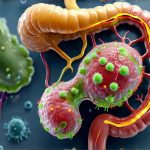The human gut is an incredibly complex ecosystem, teeming with trillions of microorganisms – bacteria, archaea, fungi, viruses – collectively known as the gut microbiota. This community isn’t merely a passive resident; it actively participates in numerous physiological processes crucial for our health, ranging from nutrient absorption and immune system development to mental wellbeing. Increasingly, research highlights the profound interconnectedness between diet and gut flora composition. What we eat directly shapes which microbes thrive, and conversely, the microbial landscape influences how we digest food and metabolize nutrients. Understanding this bidirectional relationship is fundamental to optimizing both digestive health and overall wellness.
High-protein diets have gained significant popularity in recent years, driven by trends like weight loss strategies, athletic performance enhancement, and bodybuilding. While often lauded for their efficacy in promoting satiety and muscle growth, the impact of significantly increasing protein intake on the delicate balance within our gut is a complex topic deserving careful examination. Simply focusing on macronutrient quantities overlooks the crucial role of microbial fermentation – the process by which gut bacteria break down undigested food components – and how altering this fermentation profile can have far-reaching consequences for health. This article will explore the intricacies of how high-protein diets affect gut flora composition, digestive fermentation processes, and potential implications for long-term wellbeing.
The Impact on Gut Microbiota Composition
A shift towards a high-protein diet typically leads to alterations in the abundance of different bacterial groups within the gut. Several studies demonstrate that increased protein intake, particularly animal protein, can favor the growth of proteolytic bacteria – microbes capable of breaking down proteins. This isn’t inherently negative; however, it often comes at the expense of saccharolytic bacteria, those which ferment carbohydrates and fiber. This reduction in carbohydrate-fermenting species can have significant implications for short-chain fatty acid (SCFA) production, discussed later. – The specific changes observed are influenced by several factors including: * The source of protein (animal vs. plant). * The overall dietary context – particularly fiber intake. * Individual gut microbiome baseline.
Animal proteins, rich in sulfur-containing amino acids like cysteine and methionine, tend to promote the growth of bacteria that produce hydrogen sulfide (H2S) during fermentation. While H2S plays a role in some physiological processes, excessive production has been linked to inflammation and potentially increased risk of inflammatory bowel disease. Plant-based protein sources generally elicit a different microbial response, often leading to a less pronounced increase in proteolytic activity and promoting the growth of beneficial bacteria associated with fiber fermentation. It’s important to note that dietary diversity remains crucial; even within a high-protein framework, incorporating varied protein sources – legumes, fish, poultry, lean meats – can help maintain a more balanced microbial ecosystem.
Furthermore, high-protein diets often result in reduced carbohydrate intake, which directly impacts the availability of substrates for saccharolytic bacteria. This can lead to a decrease in bacterial diversity overall. A diverse gut microbiome is generally considered a marker of health, as it provides resilience and functional redundancy – meaning the system is better equipped to adapt to changes and maintain stability. Lower diversity has been associated with increased susceptibility to disease and impaired immune function. Therefore, simply increasing protein intake without considering the impact on carbohydrate sources can inadvertently compromise gut health. Understanding how menstrual cycles influence digestion is also vital for personalized dietary approaches.
Fermentation byproducts and their effects
Digestive fermentation isn’t just about breaking down food; it’s about what is produced during that breakdown. When proteins reach the colon undigested – which is more likely with high protein intake, particularly if fiber is insufficient – proteolytic bacteria get to work. Their metabolic activities yield a range of compounds, including branched-chain fatty acids (BCFAs), indoles, phenols, and ammonia. While some BCFAs can be beneficial, excessive production of the others can have detrimental effects. – Indoles and phenols, for example, are potentially toxic metabolites that may contribute to inflammation and gut barrier dysfunction.
Ammonia is another byproduct of protein fermentation that requires detoxification by the liver. A chronically high ammonia load can strain liver function and potentially contribute to systemic inflammation. The production of hydrogen sulfide (H2S), as mentioned earlier, is particularly concerning in the context of animal protein consumption. H2S can disrupt gut barrier integrity, increase intestinal permeability (“leaky gut”), and promote inflammatory responses. It’s important to remember that these fermentation byproducts aren’t always harmful in small quantities; however, a high-protein diet, coupled with low fiber intake, can create conditions that favor their overproduction.
The balance between protein and carbohydrate fermentation profoundly influences the types of metabolites produced. When carbohydrates are abundant, saccharolytic bacteria flourish, generating short-chain fatty acids (SCFAs) such as acetate, propionate, and butyrate. SCFAs are key to gut health; they provide energy for colonocytes (cells lining the colon), strengthen the gut barrier, reduce inflammation, and even influence brain function. A shift towards increased protein fermentation reduces SCFA production, potentially compromising these beneficial effects. The importance of gut acidity cannot be overstated when considering these processes.
The Role of Fiber in Mitigating Negative Effects
Fiber plays a critical role in modulating the impact of high-protein diets on gut health. It acts as a prebiotic – food for beneficial bacteria – and influences the rate of digestion, reducing the amount of undigested protein reaching the colon. – Increasing fiber intake alongside a high-protein diet can significantly alter the fermentation profile.
Soluble fiber, found in foods like oats, beans, and apples, is particularly effective at slowing down digestion and promoting SCFA production. Insoluble fiber, present in whole grains and vegetables, adds bulk to stool and helps maintain gut motility. A synergistic relationship exists between fiber and protein: adequate fiber intake can help buffer the negative consequences of increased protein fermentation. It encourages the growth of saccharolytic bacteria, boosting SCFA production and diluting the concentration of potentially harmful metabolites from protein breakdown.
Specifically, resistant starch – a type of carbohydrate that resists digestion in the small intestine – is exceptionally beneficial. It reaches the colon intact, where it’s fermented by bacteria into butyrate, a potent anti-inflammatory SCFA. Incorporating sources of resistant starch (cooked and cooled potatoes/rice, green bananas) can help counteract the negative effects of high protein intake on gut microbial balance. Furthermore, the type of fiber matters; different fibers support the growth of different bacterial species. A diverse range of fiber sources is therefore ideal for fostering a robust and resilient microbiome. Rotating foods can also support this diversity.
Long-Term Implications & Considerations
The long-term consequences of sustained alterations in gut flora composition due to high-protein diets are still being investigated, but emerging evidence suggests potential links to chronic diseases. Chronic inflammation, driven by an imbalance in the gut microbiota (dysbiosis) and the production of harmful metabolites, is a common underlying factor in many health problems, including obesity, type 2 diabetes, cardiovascular disease, and autoimmune disorders. A consistently disrupted fermentation profile can exacerbate this inflammation.
While high-protein diets are often used for weight management, it’s crucial to remember that gut health plays an integral role in metabolic regulation. The microbiome influences energy extraction from food, glucose metabolism, and fat storage. Dysbiosis can disrupt these processes, potentially hindering long-term weight management efforts. – Moreover, the gut microbiota is intimately connected to the brain via the gut-brain axis. Alterations in microbial composition and fermentation products can impact neurotransmitter production, mood regulation, and cognitive function. Stress and mental wellbeing are key factors to consider here as well.
Ultimately, optimizing gut health requires a holistic approach that goes beyond simply focusing on macronutrient ratios. It involves prioritizing dietary diversity, incorporating adequate fiber intake, staying hydrated, managing stress levels, and considering the use of probiotic or prebiotic supplements (under professional guidance). A ‘one-size-fits-all’ approach to nutrition is rarely effective; individual responses to high-protein diets can vary significantly based on pre-existing gut microbiome composition, genetics, and lifestyle factors. Regularly assessing your digestive health and making adjustments to your diet as needed is essential for maintaining a healthy gut ecosystem. Daily rituals can also be incredibly beneficial in supporting long-term digestive health, and understanding how hormonal fluctuations might play a role is important too. Finally, consider food temperature and meal pacing for optimal digestion.


















